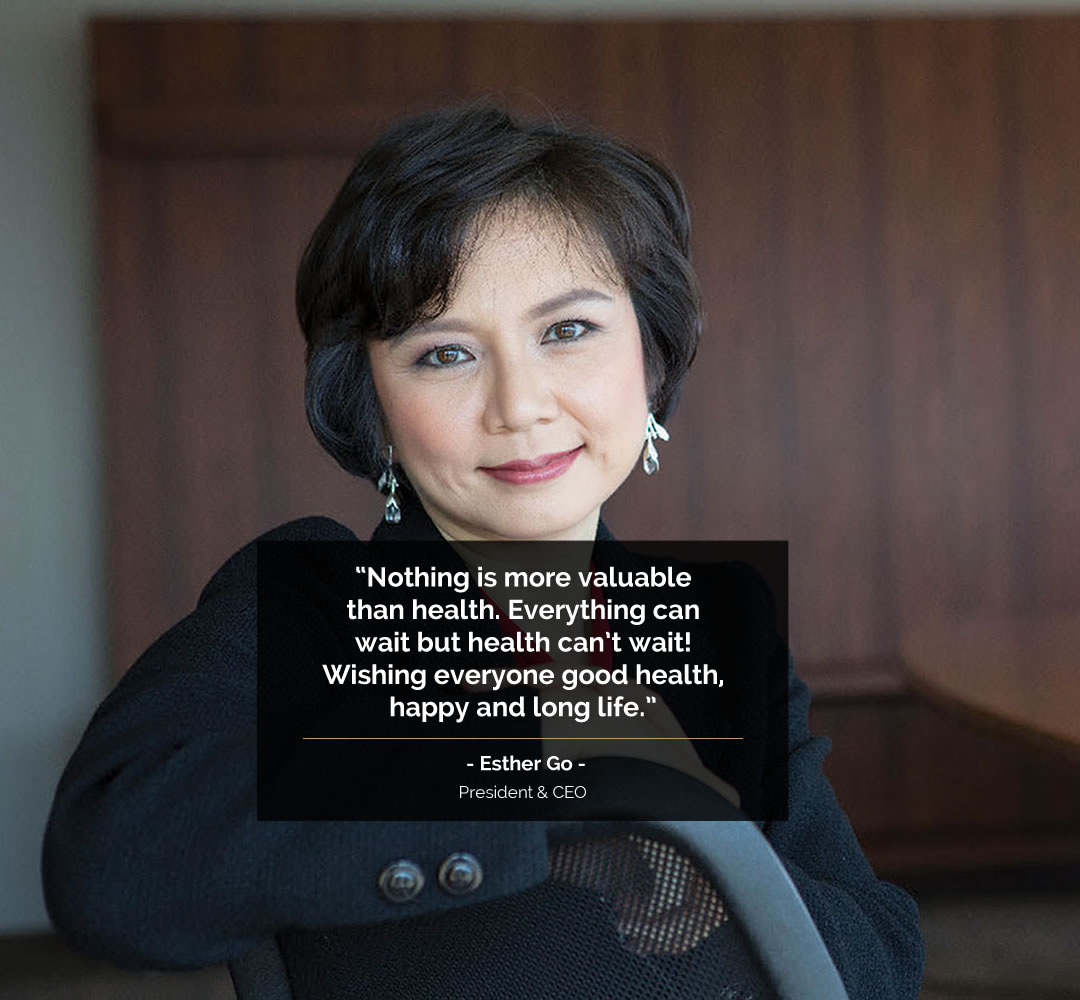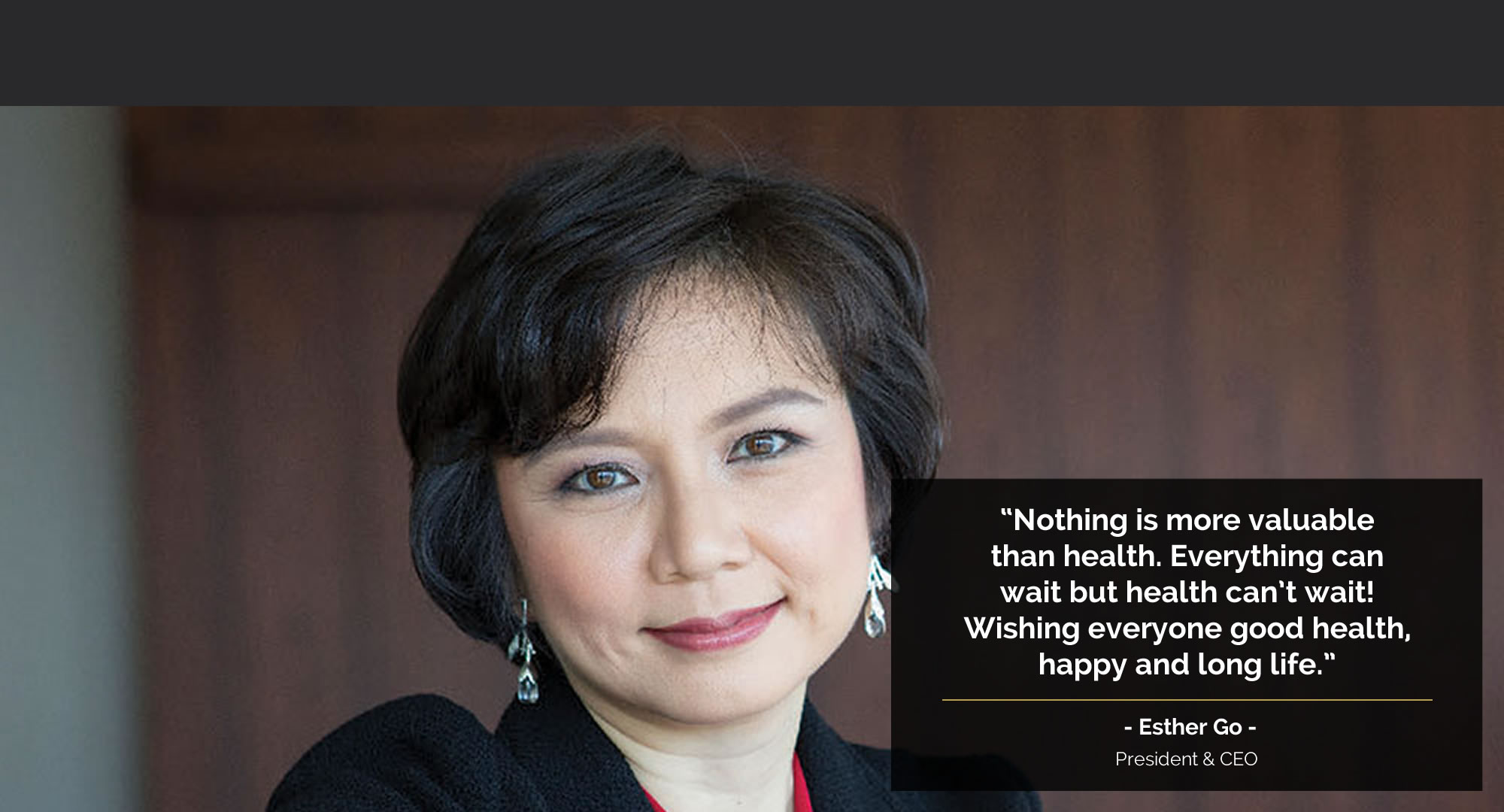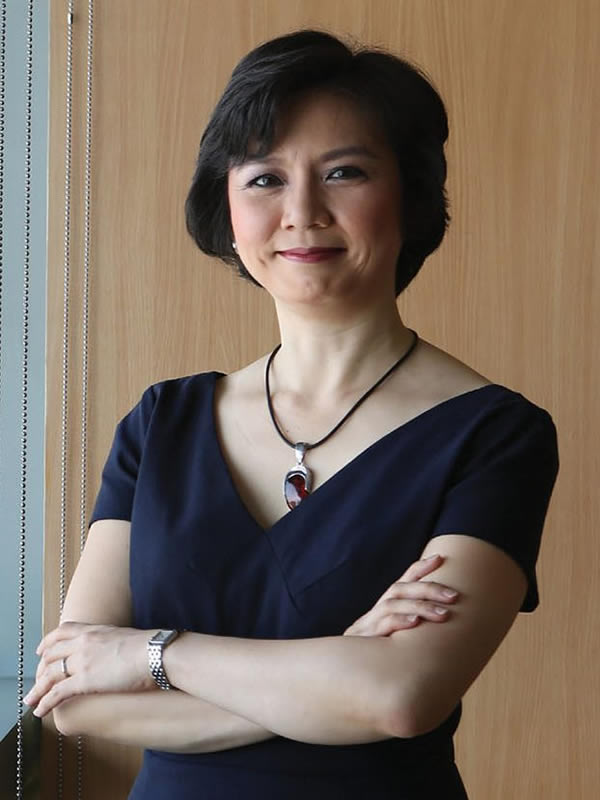

OUTSTANDING CATEGORY
ESTHER GO
PRESIDENT & CEO
Esther Go is the chief geek at MediLink Network, a company that processes over 100 million healthcare transactions daily for many of the leading HMOs and insurance companies in the Asia Pacific region.
Born and raised in the Philippines, Esther left home to attend university in America. Accustomed to traditional Asian education methods that emphasized technical proficiency and speed, Esther floundered at liberal arts studies. According to Esther, “I was not accustomed to expressing a point of view. Academics, for me, was about parroting back answers found in a book or performing calculations.” To survive university, Esther switched to computer science, where she naturally felt at ease — the way a duck takes to water. Esther had started programming from an early age since her father ran a computer services company. She was further encouraged when invited by the university’s computer science department to serve as a teaching and research assistant.
Over her career, Esther had worked in North America, Asia and Europe in management consulting, banking, healthcare, and product development, before drawing back full circle to technology, her first passion and avocation.
From only 7 employees when Esther first joined MediLink in 2006, the company has grown its team to over 200, serving over 2 million lives from 70,000 corporations, and counting the region’s largest Health Maintenance Organizations (HMOs) and Insurance companies among its valued clients. Headquartered in the Philippines, the company has since expanded its services to the Asia Pacific region.
Inspired by how ATMs changed the way people banked, MediLink provides platform services for the health ecosystem. MediLink operates the electronic network for health sector stakeholders to transact with each other anytime, anywhere, on any channel. Patients and family members may use MediLink’s apps to check on their healthcare benefits, or request authorization for medical services. Doctors and hospitals use a different app to determine payment status for services that have been rendered. Insurers and corporations keep track of utilizations and manage their portfolio’s risk profile, and plan interventions such as health screening and wellness programs. Stakeholders have a range of channel options: such as full-service concierge staff located onsite or at hospitals, phone, email or chat support, or self-service on a mobile device or kiosk.
MediLink has introduced a number of firsts to the healthcare industry–fully automated eligibility check, artificial-intelligence-based transaction processing, and electronic payment settlement. Without MediLink’s services, patients might still have to access healthcare the old-fashioned way: by calling a customer service hotline, filling out paper forms, first paying out-of-pocket during time of use, then filing for reimbursement with the company or insurer after the fact. With MediLink’s platform, patients may simply tap their card at a kiosk or login online, request for authorization, print the guarantee then present it to a doctor for service without having to bring out their wallet or file paperwork after a medical procedure.

The objective is to turn back the pandemic of lifestyle diseases such as hypertension, diabetes, and stroke that is spreading worldwide. The worrisome trend is observable across different countries, regardless of the general level of education or economic development.
While living in America, Esther had an epiphany while waiting to be discharged from a US hospital after giving birth to her daughter. As was the common practice in America, patients can be discharged from the hospital even before the final bill is computed, and the hospital mails the bill to the patient’s home weeks later. Esther thought to herself: Philippine hospital discharge processes are comparatively more “efficient” – out of necessity. Hospitals must compute the final bill and settle the payment before discharging the patient. This causes the patient to have to wait for the bill, sometimes for hours. However, if a patient is discharged before the hospital bill is settled, it may be impossible for the creditor to find the patient and collect any remaining balances as the Philippines does not have a national ID system or updated records for each citizen. MediLink has since been focused on using technology to achieve a triple win: streamlining customers’ health care experience while ensuring that service providers are paid promptly, and insurers have visibility to evaluate the health status and risk profile of their portfolio.
Esther considers technology to be the ultimate meritocracy as all practitioners have access to the same toolkits available on the internet. Whereas IT practitioners in developed countries may focus on the latest technology stack, in a developing country, solutions just need to span a wider set of technologies – some are cutting edge such as machine learning and smart mobile devices, while others are for backward compatibility to reach users who still use legacy technology such as SMS.
Esther believes that health and IT are among the best equalizers. MediLink is committed to democratizing healthcare access and serving its diverse member base consisting of company executives, office workers, factory workers, drivers, and field technicians, to name a few. MediLink uses IT tools to detect and minimize fraud, helping to keep ecosystem stakeholders accountable, and healthcare costs affordable. Automation is MediLink’s primary means to ensure that services are consistent, scalable and affordable.
As a hands-on leader, tech evangelist and early adopter, Esther is deeply involved in product development. The MediLink team is spurred to innovate knowing that they have both the moral support and access to the best technology toolkits available in the market. Thanks to Moore’s law, technology is constantly becoming better and cheaper. Grounded by this principle, the MediLink team likewise is constantly looking for ways to improve its health technology solutions, while at the same time bringing the costs down.
MediLink vision and mission is to harness technology to empower healthier communities with efficient, accessible and affordable healthcare options.
Medical costs are increasing all the time, with no sign of turning back. Populations are also growing, and aging. Realistically, there will never be enough supply to meet all the pent-up demand, and the only way to stretch the available supply is to use IT as enablers to scale services to as many people as possible at the lowest possible cost.
MediLink’s team of innovators is energized by the conviction that they could help shape the healthcare landscape in the markets they serve, for the better. Easy access to health means early treatment and better health. And better health enables one to freedom to pursue happiness.
For the MediLink team, the next frontier is finding ways to engage individuals to actively monitor and enhance their personal health through their mobile devices. The objective is to turn back the pandemic of lifestyle diseases such as hypertension, diabetes, and stroke that is spreading worldwide. The worrisome trend is observable across different countries, regardless of the general level of education or economic development.
OUTSTANDING CATEGORY
ESTHER GO
PRESIDENT & CEO
Esther Go is the chief geek at MediLink Network, a company that processes over 100 million healthcare transactions daily for many of the leading HMOs and insurance companies in the Asia Pacific region.
Born and raised in the Philippines, Esther left home to attend university in America. Accustomed to traditional Asian education methods that emphasized technical proficiency and speed, Esther floundered at liberal arts studies. According to Esther, “I was not accustomed to expressing a point of view. Academics, for me, was about parroting back answers found in a book or performing calculations.” To survive university, Esther switched to computer science, where she naturally felt at ease — the way a duck takes to water. Esther had started programming from an early age since her father ran a computer services company. She was further encouraged when invited by the university’s computer science department to serve as a teaching and research assistant.
Over her career, Esther had worked in North America, Asia and Europe in management consulting, banking, healthcare, and product development, before drawing back full circle to technology, her first passion and avocation.
From only 7 employees when Esther first joined MediLink in 2006, the company has grown its team to over 200, serving over 2 million lives from 70,000 corporations, and counting the region’s largest Health Maintenance Organizations (HMOs) and Insurance companies among its valued clients. Headquartered in the Philippines, the company has since expanded its services to the Asia Pacific region.
Inspired by how ATMs changed the way people banked, MediLink provides platform services for the health ecosystem. MediLink operates the electronic network for health sector stakeholders to transact with each other anytime, anywhere, on any channel. Patients and family members may use MediLink’s apps to check on their healthcare benefits, or request authorization for medical services. Doctors and hospitals use a different app to determine payment status for services that have been rendered. Insurers and corporations keep track of utilizations and manage their portfolio’s risk profile, and plan interventions such as health screening and wellness programs. Stakeholders have a range of channel options: such as full-service concierge staff located onsite or at hospitals, phone, email or chat support, or self-service on a mobile device or kiosk.
MediLink has introduced a number of firsts to the healthcare industry–fully automated eligibility check, artificial-intelligence-based transaction processing, and electronic payment settlement. Without MediLink’s services, patients might still have to access healthcare the old-fashioned way: by calling a customer service hotline, filling out paper forms, first paying out-of-pocket during time of use, then filing for reimbursement with the company or insurer after the fact. With MediLink’s platform, patients may simply tap their card at a kiosk or login online, request for authorization, print the guarantee then present it to a doctor for service without having to bring out their wallet or file paperwork after a medical procedure.

The objective is to turn back the pandemic of lifestyle diseases such as hypertension, diabetes, and stroke that is spreading worldwide. The worrisome trend is observable across different countries, regardless of the general level of education or economic development.
While living in America, Esther had an epiphany while waiting to be discharged from a US hospital after giving birth to her daughter. As was the common practice in America, patients can be discharged from the hospital even before the final bill is computed, and the hospital mails the bill to the patient’s home weeks later. Esther thought to herself: Philippine hospital discharge processes are comparatively more “efficient” – out of necessity. Hospitals must compute the final bill and settle the payment before discharging the patient. This causes the patient to have to wait for the bill, sometimes for hours. However, if a patient is discharged before the hospital bill is settled, it may be impossible for the creditor to find the patient and collect any remaining balances as the Philippines does not have a national ID system or updated records for each citizen. MediLink has since been focused on using technology to achieve a triple win: streamlining customers’ health care experience while ensuring that service providers are paid promptly, and insurers have visibility to evaluate the health status and risk profile of their portfolio.
Esther considers technology to be the ultimate meritocracy as all practitioners have access to the same toolkits available on the internet. Whereas IT practitioners in developed countries may focus on the latest technology stack, in a developing country, solutions just need to span a wider set of technologies – some are cutting edge such as machine learning and smart mobile devices, while others are for backward compatibility to reach users who still use legacy technology such as SMS.
Esther believes that health and IT are among the best equalizers. MediLink is committed to democratizing healthcare access and serving its diverse member base consisting of company executives, office workers, factory workers, drivers, and field technicians, to name a few. MediLink uses IT tools to detect and minimize fraud, helping to keep ecosystem stakeholders accountable, and healthcare costs affordable. Automation is MediLink’s primary means to ensure that services are consistent, scalable and affordable.
As a hands-on leader, tech evangelist and early adopter, Esther is deeply involved in product development. The MediLink team is spurred to innovate knowing that they have both the moral support and access to the best technology toolkits available in the market. Thanks to Moore’s law, technology is constantly becoming better and cheaper. Grounded by this principle, the MediLink team likewise is constantly looking for ways to improve its health technology solutions, while at the same time bringing the costs down.
MediLink vision and mission is to harness technology to empower healthier communities with efficient, accessible and affordable healthcare options.
Medical costs are increasing all the time, with no sign of turning back. Populations are also growing, and aging. Realistically, there will never be enough supply to meet all the pent-up demand, and the only way to stretch the available supply is to use IT as enablers to scale services to as many people as possible at the lowest possible cost.
MediLink’s team of innovators is energized by the conviction that they could help shape the healthcare landscape in the markets they serve, for the better. Easy access to health means early treatment and better health. And better health enables one to freedom to pursue happiness.
For the MediLink team, the next frontier is finding ways to engage individuals to actively monitor and enhance their personal health through their mobile devices. The objective is to turn back the pandemic of lifestyle diseases such as hypertension, diabetes, and stroke that is spreading worldwide. The worrisome trend is observable across different countries, regardless of the general level of education or economic development.


